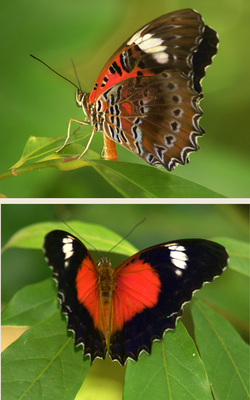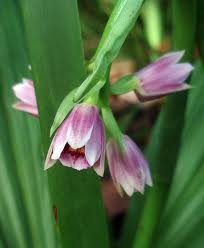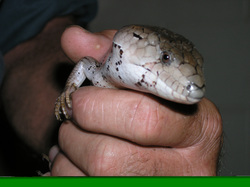
Hot and uncomfortably humid it may be, but the plants just love it. Trees are bursting into life, almost as if the bits remaining to them have been pushed into action by the cyclone.
Insects, many large and quite beautiful, like the varied butterflies and dragonflies so prevalent at this time, bumble around, sometimes colliding with one as one walks. What a privilege it is to have a Ulysses butterfly land on one’s shoulder, or a large green dragonfly perch on one’s hand. And in many places it is worth taking a second look, because all is often not what it seems.
On a young currajong tree in the garden, for example, what I thought was new growth was not one, but two, giant stick insects. They merged so well with the colour of the real twigs that to look away was to lose them. By next morning they were gone.

Geodorum is a ground orchid which, as its name suggests, is deciduous in winter.
In spring the leaves begin to appear and just before Christmas – like a gift – its pink flowers seem to pop up everywhere. The flower head is drooping, but it is worth lifting it to see how, small though it is, how typical an orchid it is. These tiny flowers are complex and full of character.
Geodorum is native to this area, and of the sixteen species growing in Asia and Polynesia, this is the only one which grows here in Australia.
After flowering, a large seed pod is generated, from which it is possible to grow these pretty little orchids.

A skink to have been a subject of considerable conversation recently, because of the large number of young it bears, is the attractive pink-tongued skink.
These highly visible creatures do not always hide their light under leafy bushels in the rainforest, though this is their natural habitat, but will enter houses to hunt for prey and may even be fed scraps. Outside, slugs and snails are major parts of their diet, and they have large rounded rear teeth with which to crush the snails’ shells.
They are skilled climbers, so do not necessarily keep their activities to the floor.
Adult pink-tongued skinks are large, some 20 centimetres long and the young are usually tiger-striped, though when they reach adulthood not all retrain their stripes. Curiously, young pink-tongued skinks have blue tongues, it is only in adulthood that their tongues are pink.
Pink tongued skinks are prolific breeders. They bear live young and 30 or more have been counted born at one time recently here in the region. Which, for gardeners who like their slugs and snails eaten rather than eating what they grow, makes them very welcome.
Don’t be surprised or alarmed if you find a pink tongued skink in a moist, shady part of the garden. It is a very useful helper to have.
We had to be away for a couple of days and returned to find she had left her bundle of babies to fend for themselves. For a long time after we returned they seemed quite still, a huge cluster of spiderlings doing exactly nothing.
But then, suddenly, things began to happen. While their mother clung to a wall at the other end of the house, the babies began to leave the nest. In a few hours they were all gone and the “cushion” in which they hatched was as pristine as when she had first formed it.
What has happened to each infant we cannot of course tell. Probably many have been eaten by geckoes. But there are still a few visible against the white ceilings.
From being a seething mass of baby spiders it is now almost as if the nest was never there. It is a very tidy ending and we hope that at least a good proportion of the youngsters will go out into the world and continue the good work of ridding it of pest insects.
Interestingly, this may be the beginning of a new chapter in the life of the female huntsman. Another much smaller spider – is it a male? – is hovering near her. We are wondering if the cycle is about to begin all over again.


